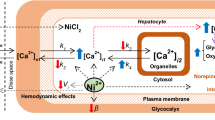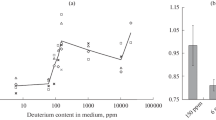Abstract
Incubation of tissue slices in physiological buffers gives rise to significant changes in the intracellular ion concentrations, which may disturb subsequent X-ray microanalysis. In the present study it was attempted to design incubation conditions that retain the in vivo conditions better. The following variables were investigated: (1) exchange of Na+ in the incubation medium for K+, and exchange of Cl–for the less permeable gluconate anion; (2) incubation at 4°C rather than at 37°C; and (3) addition of dextran to the incubation medium. Brief exposure (a few seconds) of liver slices to a buffer causes changes in the intracellular Na, Cl and K concentrations, depending on the ionic composition of the buffer. Incubation in a normal physiological (high NaCl) buffer at 37°C results in a further increase of Na and Cl and a further decrease in K in liver cells. The changes reach a maximum at 30 min and the concentrations then remain stable throughout a 2-h incubation. Incubation in sodium gluconate medium or addition of dextran to the physiological buffer somewhat reduces the changes in the intracellular ion composition (compared to the standard physiological incubation medium). Incubation in potassium gluconate medium results in a decrease in cellular Na and an increase in K. Quantitative morphological studies show that tissue oedema is observed to the same extent in hepatocytes incubated in sodium gluconate, potassium gluconate and physiological buffer containing 10% dextran. However, these buffers cause significantly less cell oedema than the physiological (high NaCl) buffer. Incubation of liver, cerebral cortex or submandibular gland slices in physiological (high NaCl) solutions at 4°C for 4 h caused a more extensive increase in Na+ and decrease in K+ than incubation at 37°C for 2 h. This suggests inhibition of the Na+, K+-ATPase under these conditions. As compared to incubation at 37°C for 2 h, tissues incubated in potassium gluconate buffer at 4°C for 4 h have a cellular K concentration closer to the in situ value. Cholinergic stimulation of tissue slices from cerebral cortex and submandibular gland at room temperature for 1 min shows the best physiological response in tissue slices preincubated at 4°C for 4 h in high KCl, potassium gluconate and high NaCl, in this order. The response can, however, only be seen, when cholinergic stimulation is carried out in a standard physiological buffer with a high NaCl concentration.
It is concluded that in vitro storage of tissue for X-ray microanalysis is best carried out at 4°C in a solution with a high K+ concentration.
Similar content being viewed by others
Author information
Authors and Affiliations
Additional information
Accepted: 24 April 1997
Rights and permissions
About this article
Cite this article
Hongpaisan, J., Roomans, G. Use of low temperature and high K+ incubation media for in vitro tissue preparation for X-ray microanalysis. Histochemistry 108, 167–178 (1997). https://doi.org/10.1007/s004180050158
Issue Date:
DOI: https://doi.org/10.1007/s004180050158




